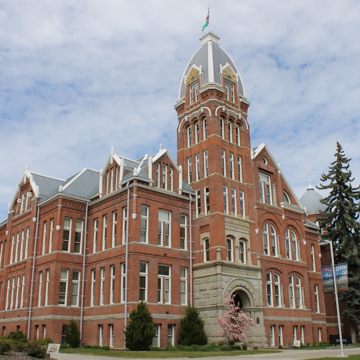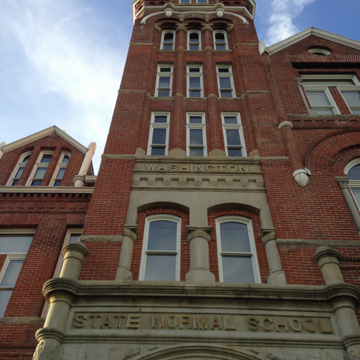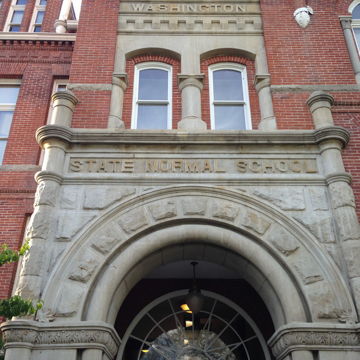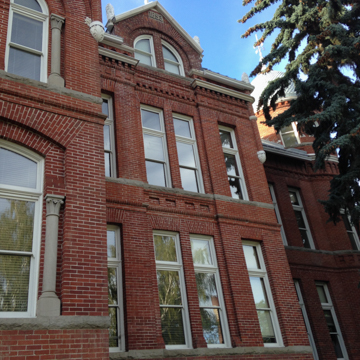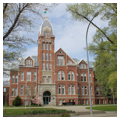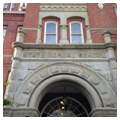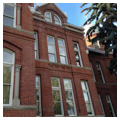You are here
Barge Hall
Barge Hall was the architectural focus of the early state legislature regarding the establishment of teacher training schools, and it embodies the lofty development dreams of the citizens of Ellensburg. The hall is named after Benjamin Franklin Barge, the first president of what was originally the Washington State Normal School. Today, Barge Hall is the oldest and most iconic building on the campus of what later became Central Washington University (CWU). It has been in continuous use since its 1894 opening.
Barge Hall, designed by architect E.C. Price in a modified version of the Richardsonian Romanesque, faces south along University Way and essentially marks the official entrance of CWU, just as it marked the original entrance to the state normal school. It is a predominantly four-story building with asymmetrical massing, a proliferation of gables, and an attached five-story central tower with a cupola providing a distinctive profile for the campus and town. The load-bearing, mostly red brick structure features belt courses of sandstone below the window openings, roof finials covered in molded sheet metal, and floors supported by wooden joists. An off-centered entrance leads to a hallway that provides access to a major staircase within the tower. Built originally as the only structure for the normal school, Price designed it with classrooms, offices, a library, a bookstore, an auditorium, a gymnasium, and facilities for elementary school children. Although no longer responsible for functioning in such an all-encompassing manner, Barge Hall continues to serve multiple functions today for CWU.
Before securing one of the three state normal schools (the towns of Cheney and Bellingham received the others), the town of Ellensburg had aspirations of achieving state capital status. The granting of statehood in 1889 and the first meeting of the legislature the following year spurred competition across Washington to attract the capital. Eventually it boiled down to a race between Olympia, North Yakima (present day Yakima), and Ellensburg, the latter of which was the largest of the three cities at the time. Ellensburg citizens were so optimistic about their town’s future that they platted 25 additions to it in 1889—but the capital was nonetheless awarded to Olympia. Still, Ellensburg was awarded one of the state’s normal schools to help ensure its economic future.
The Washington State Normal School (“normal” borrowed from the French ecole normale— a secular, non-parochial teacher training institution) officially opened its doors in Ellensburg in 1891, renting space from what was the Washington Public School. Barge, an educator, organizer, and orator with a long history in public school systems of the South and Midwest, was selected as the first president and he guided the fledgling institution through its initial years. In 1893, some $60,000 was set aside for a new building to replace the public school. After a short search, E.C. Price, a local, was chosen to design the project, and John Nash and the H.A. Ban Fossen Company—also locals—were hired to build it. Because of the choice of a local design and construction team, several out of town newspapers harangued the State Normal Board of Trustees with charges of favoritism.
Barge was replaced by the Board of Trustees for unknown reasons in 1894—the same year that Barge Hall opened. The normal school grew over the decades, training many generations of teachers and becoming the flagship institution of Ellensburg. In 1961, reflecting a growing emphasis on liberal arts education, what had been named the Central Washington College of Education in 1937 became Central Washington State College, and then Central Washington University in 1977. Despite the name changes and the growth of the institution, Barge Hall remains the anchor of campus life and a major university symbol.
References
“Barge Hall Ceremony Prompts Tales.” Ellensburg Daily Record(Ellensburg, WA), October 29, 1993.
“Barge Hall History is Official.” Ellensburg Daily Record(Ellensburg, WA), September 12, 1977.
“Barge Hall is Historic Place.” Ellensburg Daily Record(Ellensburg, WA), January 14, 1977.
Blair, Karen. “Central Washington University.” Essay 8822. HistoryLink.org: The Free Online Encyclopedia of Washington State History, December 10, 2008. Accessed June 28, 2017. www.historylink.org.
Lentz, Florence K., “Washington State Normal School Building,” Kittitas County, Washington. National Register of Historic Places Inventory–Nomination Form, 1976. National Park Service, U.S. Department of the Interior, Washington, D.C.
Mohler, Samuel R. The First 75 Years: A History of Central Washington State College. Ellensburg: Central Washington State College, 1967.
Rose, Joseph. “The Demolition of Barge Hall, Fables of the Reconstruction.” Ellensburg Daily Record(Ellensburg, WA), February 22, 1992.
Writing Credits
If SAH Archipedia has been useful to you, please consider supporting it.
SAH Archipedia tells the story of the United States through its buildings, landscapes, and cities. This freely available resource empowers the public with authoritative knowledge that deepens their understanding and appreciation of the built environment. But the Society of Architectural Historians, which created SAH Archipedia with University of Virginia Press, needs your support to maintain the high-caliber research, writing, photography, cartography, editing, design, and programming that make SAH Archipedia a trusted online resource available to all who value the history of place, heritage tourism, and learning.















